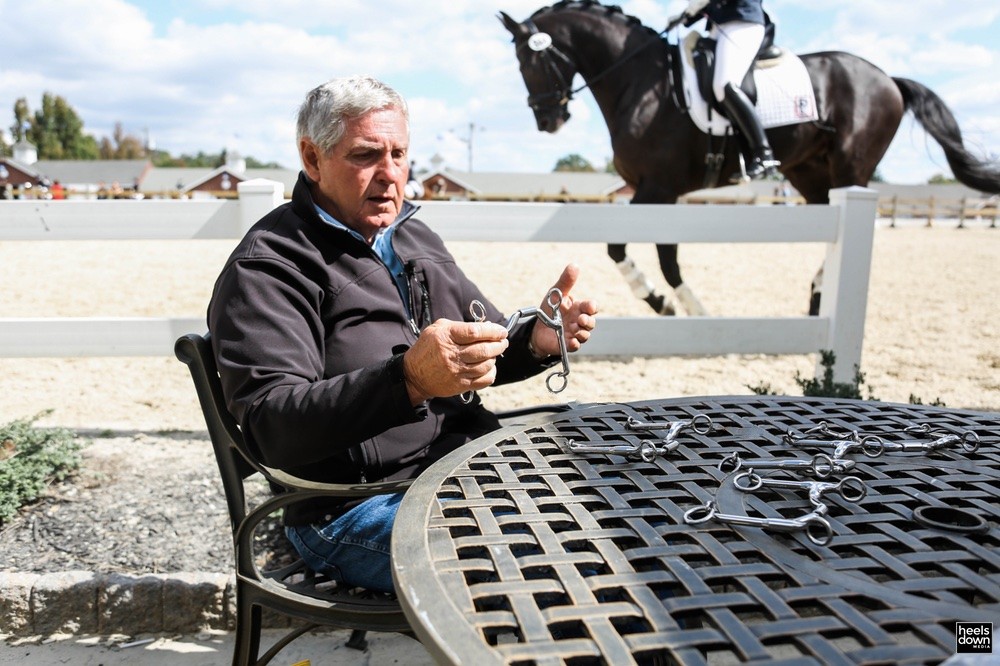Bits and Pieces: The Great Bitting Debate

To bit or not to bit? That seems to be a popular (or infamous, depending on how you look at it) discussion on the minds of many equestrians. The choice of bit is reliant on several factors: discipline, training level of the horse, training level of the rider, “problems” the rider is attempting to fix, and much more. For co-founder of Myler Bits Dale Myler, the question has never been about what problem to solve with what bit. For him, it’s about answering the questions the horse is presenting to the rider with the right tools.
“The horse will explain it to you if you listen to him,” Dale said of problem solving. “Bitting up” — the practice of using a stronger bit or a more complicated bit to try to solve an issue — is a practice Dale is attempting to avert with his line of bit options.
Dale breaks it down simply: “In what way is your horse evading the pressure of the bit? Is he tossing his head, bearing down and getting heavy on the forehand, going behind the vertical, putting his tongue over the bit? These are all ways to escape the pressure on the tongue.”
He demonstrates by putting two fingers in the center of his palm, which represents a tongue. “If I put my fingers in the center of your tongue and press down, where are you going to go? Away from the pressure.”
Horses need to have the ability to move their tongue freely, he says. Since there are several muscles that directly attach to the shoulder and the TMJ area of the horse, it’s important to achieve the right amount of pressure so that the horse is responsive but totally relaxed in the mouth.
“If you’ve got tension in the mouth, you’re going to have tension in the whole body. You have to be able to move the horse’s shoulder around, and that connection to the mouth cannot be achieved without relaxation. A horse who is resisting and hollow can not lift his shoulders and bring the energy from behind. If you clamp your teeth together for a period of time, it won’t be long before you feel that tension in the back of your neck — it’s the same for a horse.”
A different solution
With varying levels of pressure offered, the Myler bit offers an even distribution of pressure that, instead of putting pressure on a single area of the tongue much like a single jointed snaffle or a French link snaffle would, allows the rider to use pressure all at once or isolated by side.
“We don’t bit horses up,” Dale explained. “We take pressure away. The problem with a horse who is heavy on the forehand is that there is too much pressure and he’s attempting to evade that. We take the pressure away, making it possible for him to relax in the mind and therefore lift the withers.”
Nosebands are another point of discussion for Dale, who pointed out that there were so many nosebands available and legal for keeping a horse’s mouth shut, but what about the process of figuring out what is causing the horse to open its mouth in the first place?
The practice of bitting is one Dale marvels at, what with the legalization of numerous bits of varying purpose. “I think we spend too much time listening to sales people or to the trainer or the person next to you,” he said. “Listen to the horse, let the horse explain to you what the problem is.”
Ensuring proper dental health is also important in the bitting process. Young horses go through multiple dental changes through the first few years of their life, much like a human child would. “Our horses get dental work twice a year through their fifth year, and then we back off unless there is an issue that needs more treatment,” Dale said. “One of the first questions I’ll ask is about the horse’s dental history and health.”
‘The mind is absolute’
The debate of using a larger, stronger bit has riders firmly ensconced on one side or the other. “Any bit is too much in the wrong hands,” some will argue. “That rider is an Olympian, so he must know the right bitting solution for his horse,” others say. With all of the chatter, though, there is not much mention to be found of the horse’s perspective. And that is our duty, is it not? To listen and empathize with our horses, who have multiple ways of communicating if we’re receptive to them.
“The mind is the last thing people think about,” Dale said. “The mind is absolute. Nothing happens without crossing the mind first. Every maneuver comes from the mind, and only by achieving that relaxation can you fully expect to control that maneuver.”



